-
Wistia Harnesses Video for Business Communications
VideoNuze readers know that I focus mainly on the media industry and how broadband video is creating disruption and opportunity across the value chain. With so much media-related broadband activity it's a constant challenge to maintain a wider lens so as to not miss any of broadband's impact in non-media segments. These can be just as exciting and significant. That's why it was compelling for me to recently have Chris Savage, CEO/co-founder of a local Boston-area early stage company called Wistia, explain their model.
Wistia is all about online video sharing and collaboration for businesses. While collaboration tools have been around for ages, and have become increasingly cheaper (think WebEx, GoToMeeting, etc.), Wistia's difference is that it focuses mainly on video.
The company's assumption is that as the cost of creating quality video has become ridiculously inexpensive and the popularity of watching video online has skyrocketed (by sites like YouTube and others), the
 environment is now right for businesses to embrace the medium to achieve increased productivity and cost-effectiveness. Given the economic climate and knowledge workers' geographic dispersion, these are no doubt goals for millions of businesses.
environment is now right for businesses to embrace the medium to achieve increased productivity and cost-effectiveness. Given the economic climate and knowledge workers' geographic dispersion, these are no doubt goals for millions of businesses.Wistia makes it simple for a project manager to set up an account and begin uploading videos which are all automatically converted to Flash. Users are invited as "viewers" or "collaborators" depending on what privileges they're to have: viewing and commenting only or uploading media and inviting others as well. When commenting users have the option of turning on a time-coded option so that when others read their comments they are jumped to that specific point in the video. Wistia also provides a powerful analytics package that tracks actual consumption of the videos, including time spent in specific segments and completion rates.
No surprise, the types of companies and their uses of Wistia vary widely. Chris explained a few: Cirque du Soleil, the circus arts performer, is using it for managers in disparate locations to review audition video when making casting decisions. Tribal DDB, a large ad agency, is using it to share rough cuts of ads with its clients to get immediate feedback. Kiva Systems, a robotics manufacturer is using it to share demonstration videos with prospective customers as part of their sales cycle. And many companies are using it for training distributed workers. When you take a moment to think about all the potential business applications, the list is mind-boggling.
Remarkably, Wistia is still just a 5 person company that has been largely bootstrapped to date. Chris and his co-founder Brendan Schwartz are twenty-something Brown University friends who have built the product by focusing tightly on customer feedback. To be sure, customer acquisition tactics are still a work in progress and pricing models are being tweaked. Currently, basic customers pay as little as $79/mo and heavy users up to $5,000/mo.
Business communications may not be as sexy as the media business, but Wistia is showing that innovative entrepreneurs are finding unexpected and exciting ways for broadband video to create new value.
What do you think? Post a comment now.
Categories: Business Apps
Topics: Wistia
-
Silverlight Gets Nod for March Madness
Microsoft's Silverlight notched another high-profile win with yesterday's announcement by CBS Sports and the NCAA that CBSSports.com's March Madness on Demand (MMOD) will offer a high definition option using powered by Silverlight.
 Over the past few years MMOD has become the signature online video sports event, with CBSSports.com successfully converting it in 2006 from a paid, subscription based model to one fully supported by ads. The payoff has been evident: in '08 MMOD had 4.8 million unique visitors (a 164% increase over '07) who watched 5 million hours of live video (an 81% increase over '07).
Over the past few years MMOD has become the signature online video sports event, with CBSSports.com successfully converting it in 2006 from a paid, subscription based model to one fully supported by ads. The payoff has been evident: in '08 MMOD had 4.8 million unique visitors (a 164% increase over '07) who watched 5 million hours of live video (an 81% increase over '07). CBSSports.com is building on its MMOD success by offering the higher quality option via Silverlight this year. Users who download the plug-in will get 1.5 mbps streams vs. the standard player's 550 kbps. Once again, all 63 games, from the first round through the championship game will be available. For office workers unable to watch on TV, online distribution continues to be a compelling value.
With MMOD, Microsoft is continuing to push Silverlight into high-profile sports events. Recall that Silverlight's inaugural run, supporting the 2008 Summer Olympics, was executed superbly. It showcased new features like multiple viewing windows and instant rewind/fast-forward. MMOD promises yet another premier opportunity for Silverlight to show its stuff.
What do you think? Post a comment now.
Categories: Broadcasters, Sports, Technology
Topics: CBS, CBSSports.com, Microsoft, NCAA, Silverlight
-
Betawave TV: Video Syndication Aimed at Kids and Moms
The "syndicated video economy" continues to mature with today's announcement of Betawave TV, a video distribution network offering video content and ads to kids age 6-17 and moms. Betawave TV is being launched by Betawave Corp., which was until recently called GoFish (and which also recently raised $22.5M). The company has amassed a U.S. publisher network totaling 25 million monthly unique visitors. I recently spoke to Betawave's executive chairman Jim Moloshok to learn more.
Betawave TV illustrates how broadband is helping merge the traditional concept of an ad network with the
 potential for widespread distribution of video to contextually targeted publisher sites. The bet here is that Betawave TV's content and ads can generate more value on its publishers' pages than just pure advertising could. Since Betawave TV's network has a heavy emphasis on gaming sites (e.g. GamesGecko, Hallpass, etc.) that don't have really have video strategies themselves, Betawave TV's offering seems like a good augment. Betawave TV will be released on sites totalling 6 million monthly uniques by the end of Q1.
potential for widespread distribution of video to contextually targeted publisher sites. The bet here is that Betawave TV's content and ads can generate more value on its publishers' pages than just pure advertising could. Since Betawave TV's network has a heavy emphasis on gaming sites (e.g. GamesGecko, Hallpass, etc.) that don't have really have video strategies themselves, Betawave TV's offering seems like a good augment. Betawave TV will be released on sites totalling 6 million monthly uniques by the end of Q1. Of course, these sites are by nature very immersive, so drawing users' attention away from their primary purpose requires compelling content. Betawave TV has a broad content strategy, including licensing from producers like Cookie Jar Entertainment, MGM and Young Hollywood to creating its own series. First up is the fashion-oriented and brand-sponsored "Raven Symone Presents." My guess is that much of Betawave TV's programming is relatively inexpensive to acquire or to produce, all the more so if Betawave TV can do more brand-sponsored deals.
Ultimately, Betawave TV is competing for audience attention and ad dollars that have traditionally flowed to major kids' TV programmers like Disney, Nickelodeon and Cartoon Network. As a piece in Mediaweek just yesterday suggested, 50-75% of ad dollars spent on kids' sites are no longer a part of integrated TV packages. The massive fragmentation of kids' attention away from just watching TV is certainly the underlying cause for this and what Betawave is banking on for success. I can attest to this trend myself: when my 8 1/2 year-old daughter gets together with friends they are far more likely to play games at AmericanGirl.com than watch Disney Channel.
No doubt Betawave TV won't be alone in pursuing kids online with syndicated video and ads. While Jim says they own 100% of the target inventory on their publishers' sites, there's no question these publishers will be evaluating plenty of competing offers in the future. Betawave TV's results will be an interesting test of how mature the video syndication opportunity actually is.
What do you think? Post a comment now.
Categories: Advertising, Syndicated Video Economy
Topics: Betawave
-
3rd test
Text appear here
-
1 Week Left for Early Bird Discount Tickets to March 17th NYC Leadership Event
A reminder that early bird discounts will end next Fri, Feb. 20th for VideoNuze's next event, the Broadband Video Leadership Evening on Tuesday, March 17th in New York City. If you're trying to make sense of the noise and excitement of the rapidly-evolving video landscape, this event is a must-attend. But why pay full fare - register today to get the early bird discount!
The evening will start with a "VideoSchmooze" cocktail/networking reception from 6pm - 7:30pm, followed
 by a panel discussion I'll moderate from 7:30pm - 9pm titled, "Broadband Video '09: Building the Road to Profitability." We have panel of top-tier digital media executives including:
by a panel discussion I'll moderate from 7:30pm - 9pm titled, "Broadband Video '09: Building the Road to Profitability." We have panel of top-tier digital media executives including:- Albert Cheng, EVP, Digital Media, Disney/ABC Television Group
- Greg Clayman, EVP, Digital Distribution & Business Development, MTV Networks
- Karin Gilford, SVP, Fancast and Online Entertainment, Comcast Interactive Media
- Curt Hecht, President, VivaKi (Publicis Groupe)
- Tom Morgan, Chief Strategy Officer, Move Networks
Click here to learn more and register for the early bird discount
All of these companies are industry leaders, pushing the edge of the broadband envelope. Among their recent initiatives, ABC just released consumer research about ad frequency in its player, VivaKi has launched "The Pool" with high-profile brands and content providers to improve video standards and Move just powered a live pre-telecast of the Grammy awards.
The event will be held at the Hudson Theater, a beautifully-renovated venue on West 44th Street just off Times Square. I'm pleased to have NATPE, VideoNuze's partner since launch, on board for the event. And I'm extremely grateful to lead sponsor Move Networks and supporting sponsors ExtendMedia, Horn Group, mPoint and PermissionTV who are making the evening possible.
I've set up a Facebook group so you can start meeting other attendees and also keep up to date on all the recent broadband news we'll discuss on the panel. Friend me on Facebook and you can join!
Note this event is on the evening before the start of the McGraw-Hill Media Summit in NYC; if you're coming in for that, plan accordingly to join us as well!
Click here to learn more and register for the early bird discount
Categories: Events
Topics: Broadband Video Leadership Evening, VideoSchmooze
-
NBA Plans Mobile/Broadband Blowout for All-Star Game this Weekend
Sports continues to be on the front lines of the broadband video revolution and with its All-Star game this weekend it's the NBA's turn to show its stuff. Not to be outdone by the Olympics, MLB or NHL, the NBA is going all out with mobile and broadband video supplements to this weekend's game festivities, building on last year's "TNT OverTime Extra" initiative.
Among other features, there will be 4 additional camera angles available in OverTime Extra. There's an
 integration with Facebook (similar to what CNN did with the inauguration) which will build community interaction during the game. New also is the NBA.com All-Star Live app which will allow iPhone users to watch the extra 4 camera angles live on their iPhones. (hmm, I wonder what AT&T thinks of all that network consumption?) And there's "All-Star Scene" offering a range of fan-generated content and interactivity.
integration with Facebook (similar to what CNN did with the inauguration) which will build community interaction during the game. New also is the NBA.com All-Star Live app which will allow iPhone users to watch the extra 4 camera angles live on their iPhones. (hmm, I wonder what AT&T thinks of all that network consumption?) And there's "All-Star Scene" offering a range of fan-generated content and interactivity.Broadband is continuing to prove itself as a highly valuable companion to traditional on-air sports coverage, opening up significant new engagement and monetization opportunities. Much more is yet to come.
What do you think? Post a comment now.
Categories: Sports
-
VideoNuze Report Podcast #6 - Feb 13, 2009
Below is the 6th edition of the VideoNuze Report podcast, for Feb. 13, 2009.
This week Daisy Whitney and I discuss the growth of mobile video and specifically new research that Cisco released earlier this week indicating massive increases in traffic over the next 5 years.
Of course mobile video has never suffered from a shortage of hype, but with the popularity of the iPhone and other smartphones, mobile video usage finally seems to be crystallizing in '09. Daisy and I discuss several apps, including one coming up this weekend from NBA.com and TNT whereby users will be able to watch 4 additional camera angles of the All-Star game on their iPhones.
In addition, we also touch on thePlatform's announcement earlier this week of newly reduced delivery and storage pricing targeted mainly for its small-to-medium sized business customers. In this economic climate reducing customer costs is critical and we discuss what thePlatform's moves mean for the market.
Click here for previous podcasts
The VideoNuze Report is available in iTunes...subscribe today!
Categories: Mobile Video, Podcasts
Topics: Cisco, iPhone, NBA, Podcast, thePlatform
-
Crunching comScore's Video Data Yields Market Insights
Last week when comScore announced data from its Video Metrix service for December '08, I made a note to myself to go back and look at all the video usage data comScore has released and see what it reveals. Below are 5 charts that I've compiled from comScore's press releases covering January 2007 - December 2008 (note comScore didn't report on every single month during this 24 month period so there are some holes in the graphs).
The first graph shows the growth in total videos viewed per month, roughly doubling from 7.2 billion views in Jan. '07 to 14.3 billion views in Dec. '08.
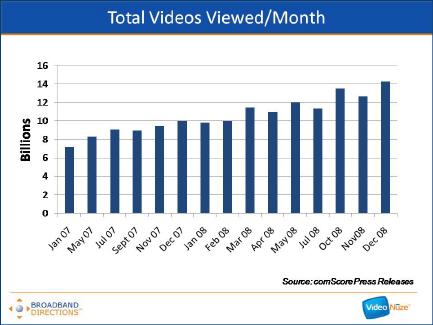
That growth is driven by a number of factors including an increase in the number of monthly viewers from 123 million in Jan. '07 (70% of U.S. Internet users) to 150 million in Dec. '08 (78.5% of U.S. Internet users).
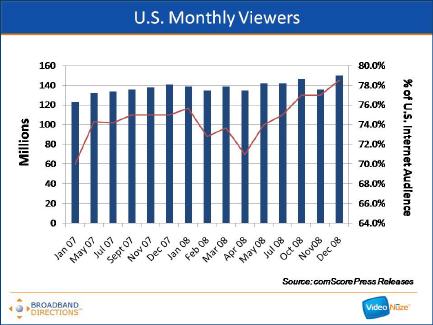
It also reflects an increase in the number of videos viewed per viewer from 59 in Jan. '07 to 96 in Dec. '08.
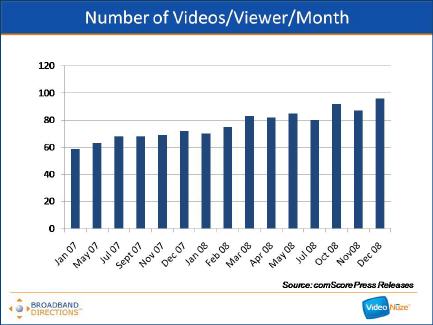
Which further translates into the growth of total number of minutes the average viewer watched per month from 151 minutes per month in Jan. '07 to 309 minutes per month in Dec. '08.
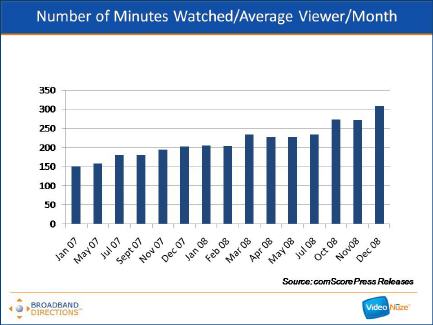 Aside from the sheer growth of the market over the last two years, the most striking thing about the comScore data is the growth in usage and market share by YouTube. Back in Jan. '07, YouTube generated approximately 1.2 billion video views per month for a 16.2% share of all videos viewed. Two years later in Dec. '08 YouTube generated approximately 5.9 billion video views per month for a 41.2% market share. YouTube's share growth is staggering: in every month but 1 during this period YouTube increased its sequential monthly views and in all but 3 months it increased its sequential monthly market share.
Aside from the sheer growth of the market over the last two years, the most striking thing about the comScore data is the growth in usage and market share by YouTube. Back in Jan. '07, YouTube generated approximately 1.2 billion video views per month for a 16.2% share of all videos viewed. Two years later in Dec. '08 YouTube generated approximately 5.9 billion video views per month for a 41.2% market share. YouTube's share growth is staggering: in every month but 1 during this period YouTube increased its sequential monthly views and in all but 3 months it increased its sequential monthly market share.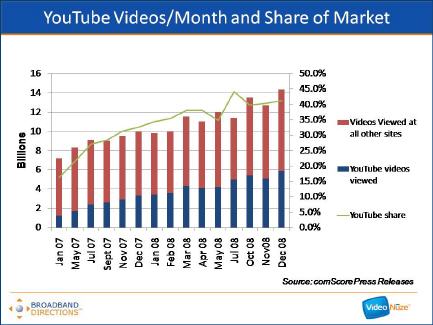
Recall that Google closed on the YouTube acquisition in Nov. '06 and at $1.65 billion, many thought Google had grossly overpaid. Some may still believe this as YouTube is still very much a work in progress in terms of how it generates revenue. But there's no questioning the phenomenal two-year run it has had in terms of its usage and market share growth. This is one of the reasons why I continue to believe YouTube is one of the most powerful platforms for eventually disrupting the traditional video distribution value chain.
If these slides are hard to view, I've uploaded them all to SlideShare.
What do you think? Post a comment now.
Categories: Aggregators
Topics: comScore, Google, YouTube


